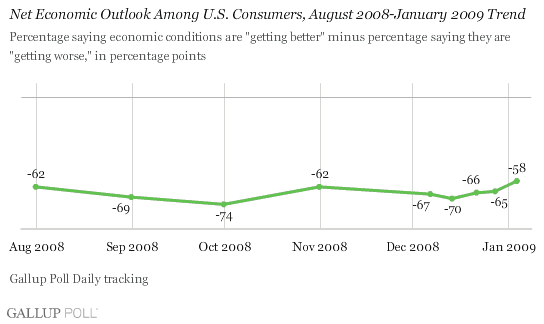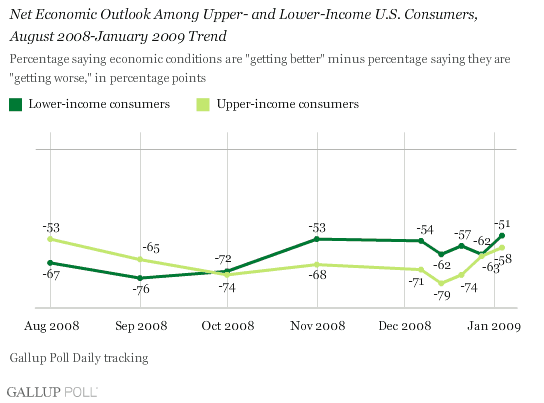PRINCETON, NJ -- Consumer expectations are getting a little better as the new year gets underway. The percentage of consumers saying the economy is "getting better" minus the percentage saying it is "getting worse" improved to -58 points during the week ending Jan. 4, 2009, after having hit -70 in mid-December as a reflection of deteriorating consumer expectations.

Both Upper- and Lower-Income Consumer Expectations Improving
Lower-income Americans (those with monthly household incomes of less than $2,000) continue to be less pessimistic than their upper-income counterparts (those with monthly incomes of $7,500 or more) about the future direction of the U.S. economy. The reverse was the case back in August and September of last year. The two income groups' outlooks became roughly equal in October, and since November, greater pessimism has been evident among upper-income Americans.
The net percentage "getting better" among lower-income Americans was -51 points last week, compared to -58 among upper-income households. Still, consumer expectations have improved among both income groups during the past week and particularly compared to mid-December.

Commentary
It seems rather ironic that consumer expectations for the future of the U.S. economy have improved somewhat even as President-elect Obama describes the economic situation as "dire," the president of the Federal Reserve Bank of Kansas City suggests the outlook for the first half of 2009 is "grim," and recent economic reports show economic activity plummeted during the fourth quarter of last year. Of course, the uptick in consumer expectations could simply reflect more positive spirits associated with the Christmas/New Year's period. Lower gas prices may also be helping encourage consumers. However, it seems more likely that many consumers, like many on Wall Street, are encouraged by talk of an enormous government stimulus plan and the soon-to-arrive Obama inauguration.
Whether consumers are encouraged by holiday cheer, talk of a new stimulus plan, or something else, it will be interesting to see how they respond to the economic headlines over the days and weeks ahead. On the one hand, they will hear about an increasingly depressing jobs situation. They are also likely to see numerous references to the potential for economic disaster as political leaders make the case for the economic stimulus legislation. Worst of all, they may end up seeing a rash of bankruptcies as the fallout of dismal holiday sales is realized.
On the other hand, there is likely to be at least a temporary euphoria as the nation celebrates the historic inauguration of the new president-elect. This optimistic atmosphere could gain momentum as the planned dramatic action by the federal government is outlined in more detail and the unprecedented actions of the Fed begin to be felt on Main Street.
Gallup will continue to monitor consumer perceptions and report on them daily as the new year unfolds.
Survey Methods
Gallup is interviewing no fewer than 1,000 U.S. adults nationwide each day during 2008 and 2009. The economic questions analyzed in this report are asked of a random half-sample of respondents each day. The results reported here are based on combined data of more than 8,000 interviews in August, September, October, and November. For results based on this sample, the maximum margin of sampling error is ±1 percentage point.
The questions for December are based on combined data of more than 3,000 interviews conducted weekly. For results based on these samples, the maximum margin of sampling error is ±2 percentage points.
Interviews are conducted with respondents on land-line telephones (for respondents with a land-line telephone) and cellular phones (for respondents who are cell-phone only).
In addition to sampling error, question wording and practical difficulties in conducting surveys can introduce error or bias into the findings of public opinion polls.
